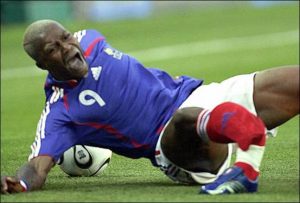Soccer is a dynamic sport which involves repetitive twisting, pivoting, jumping and running. Due to this, it creates a wide variety of injuries which are prevalent in both the professional and amateur scene. Injuries are most common in the lower limb with knee, ankle and soft tissue injuries most common. Here Bodysmart Physiotherapist Matt Fulco outlines the four most common injuries seen in soccer, and their prospective management strategies:
1. Ankle ligament sprain
The anterior-talo fibular ligament (ATFL) is the most commonly injured ankle ligament during soccer. There are a number of mechanisms for injury, with inwards rolling of the ankle under body weight, awkward landings or sudden twisting movements the most apparent. Pain occurs on the lateral side of the ankle (outside), although in severe injuries, pain can also be felt on the medial side (inside). The grade of injury will determine how long rehabilitation will take, with most sprains taking between 2 and 5 weeks to heal, however higher grade injuries may take several months.
Initial management utilizes the RICER principle, with physiotherapy treatment essential to restore full muscle strength, flexibility and proprioception to the injured ankle joint and prevent recurrence. It is common that one ankle sprain can lead to many sprains of the same ankle if not managed correctly.
2. Hamstring muscle tears
As soccer requires sprinting, large amounts of load can be placed through the hamstring. Sprinting is the most common mechanism for injury to the hamstring, although overreaching the leg can also result in injury. The biceps femoris muscle of the hamstring (the most lateral) is injured the most frequently in the hamstring muscle group due to its anatomy. When the injury occurs, there will be a sudden pain in the posterior thigh, and there will be pain when trying to extend the knee while walking or running.
Initial management: As with ankle sprains, applying the RICER principle when the injury initially occurs is important to decrease inflammation and pain. Physiotherapy helps with improving flexibility and muscle strength in the hamstring, both of which are essential for preventing re-injury. As sprinting is a large part of soccer, a weak hamstring muscle will have a higher chance of leading to injury.
3. Knee ligament injuries
Anterior cruciate ligament (ACL) injuries have become more common in soccer. High amounts of twisting, pivoting and jumping put the ACL at risk, and it is injured when one of these movements goes wrong. ACL injuries will be associated with a ‘snap’ or ‘crack’ when the injury occurs, with the site of pain varying between each individual. Following the injury, the sensation of the knee ‘giving way’ occurs when putting load through the leg. The majority of ACL injuries result in surgical treatment where a ‘reconstruction’ is taken place, with rehabilitation timeframes varying between 9 to 12 months. Physiotherapy led rehabilitation is critical during this period to restore full function and muscle strength to the knee, as well as to prevent a future ACL injury. The medial collateral ligament (MCL) is also commonly injured, although more due to contact, rather than non-contact and is associated with medial knee pain. All cases of MCL injuries are managed conservatively through physiotherapy.
4. Adductor muscle strains
The adductor muscle group is particularly vulnerable in soccer players due to the large amounts of twisting, pivoting and kicking. Injury to these muscles will be associated with inner thigh pain, and occurs when there is an overload of the adductors resulting in a strain or tear.
Initial management: As with other acute injuries, the RICER principle should be applied to decrease inflammation and pain in the area with physiotherapy treatment important to speed up recovery. A large proportion of adductor injuries can be related to deficiencies in strength around the hip, hence the overload of the adductor muscles. Therefore, physiotherapy led rehabilitation not only aims to decrease pain levels and improve flexibility, but also enhance pelvic control and strength to prevent the recurrence of the injury.
 Written by Matt Fulco. Through the completion of extensive post graduate professional development, Matt demonstrates a very high level of knowledge and skill for his age. He has a very well rounded skill set that enables him to accurately assess and diagnose a vast range of injuries and implement the best evidence based treatments available.
Written by Matt Fulco. Through the completion of extensive post graduate professional development, Matt demonstrates a very high level of knowledge and skill for his age. He has a very well rounded skill set that enables him to accurately assess and diagnose a vast range of injuries and implement the best evidence based treatments available.
If you have suffered a soccer injury recently book into see Matt who has extensive knowledge of soccer injuries:











